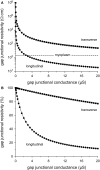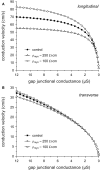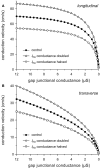Arrhythmogenic right ventricular cardiomyopathy: considerations from in silico experiments
- PMID: 22754532
- PMCID: PMC3385583
- DOI: 10.3389/fphys.2012.00168
Arrhythmogenic right ventricular cardiomyopathy: considerations from in silico experiments
Abstract
Objective: Arrhythmogenic right ventricular cardiomyopathy (ARVC) is associated with remodeling of gap junctions and also, although less well-defined, down-regulation of the fast sodium current. The gap junction remodeling and down-regulation of sodium current have been proposed as contributors to arrhythmogenesis in ARVC by slowing conduction. The objective of the present study was to assess the amount of conduction slowing due to the observed gap junction remodeling and down-regulation of sodium current.
Methods: The effects of (changes in) gap junctional conductance, cell dimensions, and sodium current on both longitudinal and transversal conduction velocity were tested by simulating action potential propagation in linear strands of human ventricular cells that were either arranged end-to-end or side-by-side.
Results: A 50% reduction in gap junction content, as commonly observed in ARVC, gives rise to an 11% decrease in longitudinal conduction velocity and a 29% decrease in transverse conduction velocity. A down-regulation of the sodium current through a 50% decrease in peak current density as well as a -15 mV shift in steady-state inactivation, as observed in an experimental model of ARVC, decreases conduction velocity in either direction by 32%. In combination, the gap junction remodeling and down-regulation of sodium current result in a 40% decrease in longitudinal conduction velocity and a 52% decrease in transverse conduction velocity.
Conclusion: The gap junction remodeling and down-regulation of sodium current do result in conduction slowing, but heterogeneity of gap junction remodeling, in combination with down-regulation of sodium current, rather than gap junction remodeling per se may be a critical factor in arrhythmogenesis in ARVC.
Keywords: arrhythmogenic right ventricular cardiomyopathy; cardiac arrhythmias; cardiac electrophysiology; cardiac myocytes; computer simulations; connexin43; gap junctions; sodium channels.
Figures








Similar articles
-
Determinants of electrical propagation and propagation block in Arrhythmogenic Cardiomyopathy.J Mol Cell Cardiol. 2024 Jan;186:71-80. doi: 10.1016/j.yjmcc.2023.11.003. Epub 2023 Nov 11. J Mol Cell Cardiol. 2024. PMID: 37956903 Free PMC article.
-
Connexin expression patterns in arrhythmogenic right ventricular cardiomyopathy.Am J Cardiol. 2013 May 15;111(10):1488-95. doi: 10.1016/j.amjcard.2013.01.299. Epub 2013 Mar 29. Am J Cardiol. 2013. PMID: 23465095
-
Silencing of desmoplakin decreases connexin43/Nav1.5 expression and sodium current in HL‑1 cardiomyocytes.Mol Med Rep. 2013 Sep;8(3):780-6. doi: 10.3892/mmr.2013.1594. Epub 2013 Jul 18. Mol Med Rep. 2013. PMID: 23877755
-
New insights into myocardial arrhythmogenesis: distribution of gap-junctional coupling in normal, ischaemic and hypertrophied human hearts.Clin Sci (Lond). 1996 Jun;90(6):447-52. doi: 10.1042/cs0900447. Clin Sci (Lond). 1996. PMID: 8697713 Review.
-
Micropatterns of propagation.Adv Cardiol. 2006;42:86-106. doi: 10.1159/000092564. Adv Cardiol. 2006. PMID: 16646586 Review.
Cited by
-
Cardiac ion channelopathies and the sudden infant death syndrome.ISRN Cardiol. 2012;2012:846171. doi: 10.5402/2012/846171. Epub 2012 Dec 5. ISRN Cardiol. 2012. PMID: 23304551 Free PMC article.
-
Chronic diastolic stretch unmasks conduction defects in an in vitro model of arrhythmogenic cardiomyopathy.Am J Physiol Heart Circ Physiol. 2023 Oct 13;325(6):H1373-85. doi: 10.1152/ajpheart.00709.2022. Online ahead of print. Am J Physiol Heart Circ Physiol. 2023. PMID: 37830983 Free PMC article.
-
SCN10A-short gene therapy to restore conduction and protect against malignant cardiac arrhythmias.Eur Heart J. 2025 May 7;46(18):1747-1762. doi: 10.1093/eurheartj/ehaf053. Eur Heart J. 2025. PMID: 39973098 Free PMC article.
-
Disease Modifiers of Inherited SCN5A Channelopathy.Front Cardiovasc Med. 2018 Oct 1;5:137. doi: 10.3389/fcvm.2018.00137. eCollection 2018. Front Cardiovasc Med. 2018. PMID: 30327767 Free PMC article. Review.
-
New insights on the cardiac safety factor: Unraveling the relationship between conduction velocity and robustness of propagation.J Mol Cell Cardiol. 2019 Mar;128:117-128. doi: 10.1016/j.yjmcc.2019.01.010. Epub 2019 Jan 22. J Mol Cell Cardiol. 2019. PMID: 30677394 Free PMC article.
References
-
- Basso C., Czarnowska E., Della Barbera M., Bauce B., Beffagna G., Wlodarska E. K., Pilichou K., Ramondo A., Lorenzon A., Wozniek O., Corrado D., Daliento L., Danieli G. A., Valente M., Nava A., Thiene G., Rampazzo A. (2006). Ultrastructural evidence of intercalated disc remodelling in arrhythmogenic right ventricular cardiomyopathy: an electron microscopy investigation on endomyocardial biopsies. Eur. Heart J. 27, 1847–185410.1093/eurheartj/ehl095 - DOI - PubMed
-
- Basso C., Fox P. R., Meurs K. M., Towbin J. A., Spier A. W., Calabrese F., Maron B. J., Thiene G. (2004). Arrhythmogenic right ventricular cardiomyopathy causing sudden cardiac death in Boxer dogs: a new animal model of human disease. Circulation 109, 1180–118510.1161/01.CIR.0000118494.07530.65 - DOI - PubMed
-
- Bhuiyan Z. A., Jongbloed J. D. H., van der Smagt J., Lombardi P. M., Wiesfeld A. C. P., Nelen M., Schouten M., Jongbloed R., Cox M. G. P. J., van Wolferen M., Rodriguez L. M., van Gelder I. C., Bikker H., Suurmeijer A. J. H., van den Berg M. P., Mannens M. M. A. M., Hauer R. N. W., Wilde A. A. M., van Tintelen J. P. (2009). Desmoglein-2 and desmocollin-2 mutations in Dutch arrhythmogenic right ventricular dysplasia/cardiomypathy patients: results from a multicenter study. Circ. Cardiovasc. Genet. 2, 418–42710.1161/CIRCGENETICS.108.839829 - DOI - PubMed
LinkOut - more resources
Full Text Sources
Miscellaneous

